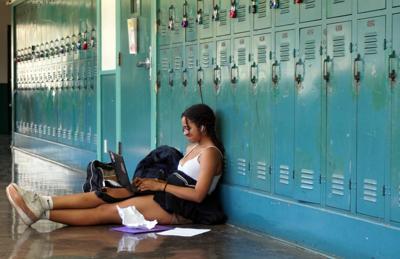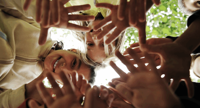
This story was originally published by EdSource. Sign up for their daily newsletter.
Top Takeaways
- Schools in San Diego County use new protocols like suicide risk screeners to improve youth suicide prevention.
- One K-8 school district found that students in fifth and sixth grades were at the highest risk of suicide.
- Social workers followed up each suicide risk screener with meetings with parents.
Schools across California may be at risk of losing social workers and counselors due to federal cuts, but in San Diego County, they are using a $7 million state grant to help shape the fight against youth suicide.
Instead of hiring more school counselors and social workers, the San Diego County Office of Education invested in the Creating Opportunities in Preventing and Eliminating Suicide (COPES) initiative, which introduces a suicide risk screener for students who might be at risk of self-harm or suicide.
The screener, based on the standard Columbia-Suicide Severity Rating Scale, is a series of six questions asked by a school social worker or counselor to identify a student who may be at risk for self-harm or suicide. Questions include:
- Have you wished you were dead or wished you could go to sleep and not wake up?
- Have you started to work out or worked out the details of how to kill yourself?
- Do you intend to carry out this plan?
- Have you ever done anything, started to do anything, or prepared to do anything to end your life?
“If a student comes in and they are saying things like, ‘I just don’t want to be here anymore, I just want to die,’ or maybe a friend has alerted us to that, we sit down with the student and talk with them,” said Sarah Cozik, an education specialist at the School for Entrepreneurship and Technology, a charter high school in San Diego County.
“What I’m looking to see is if they have a plan, if they have intent to go through that plan, and if they have the means to go through with that plan,” she said.
Although several schools in California have used the suicide risk screener, the COPES initiative in San Diego County is one of the first to provide standardized training. The county Department of Education retrained social workers and school counselors in conducting screeners and developed a new countywide database of resources, called the “resource-mapping tool,” to provide students with individualized resources.
For Heidi Graver, a social worker at the K-8 Lemon Grove School District in San Diego County, the initiative also helped identify younger students who could be at risk of self-harm but are often overlooked.
“A majority of our high-risk kids are coming from fifth and sixth grade, and so it made us focus on what we’re doing for those younger kiddos,” Graver said.
At Lemon Grove, about 22% of students said they had considered suicide, and about 39% said they experienced chronic sadness during the 2022-23 school year. Those numbers have steadily decreased since the initiative, with 13% saying they considered suicide and 29% saying they experienced chronic sadness in the 2024-25 school year.
The number of suicide risk screenings conducted at both Lemon Grove and the School for Entrepreneurship and Technology has steadily increased in the past four years. At both school sites, the number of boys and Latino youth referred for suicide risk screenings has also increased.
Through screeners and data tracking, both Cozik and Graver also tailored their efforts to the needs of their own students. After Cozik noticed a surge in students coming to her with eating disorders, she used the resource-mapping database to provide more comprehensive help for those students.
“I had a student coming to me with some serious challenges with eating disorders, and I (was) helping them share that with their parent,” Cozik said. “But once we share with the parent, they still need help outside of school, and through resource-mapping, I can give parents access to 25 to 30 different (eating disorder) therapists and agencies.”
For Graver, a new system of suicide risk screeners also helped shape the district’s new policies for parent engagement. For example, social workers at Lemon Grove are now required to meet with the parents of every student who is screened for suicide risk, regardless of how severe their risk of suicide may be.
“If I have a student verbalizing risk to themselves, and I have a parent who’s like, ‘I’m scared. What do I need to do?’ That’s a parent who’s showing me we’re in this together,” Graver said. “But I also hear from many families, ‘They’re just looking for attention.’ We try to switch that to they’re not attention-seeking, they’re connection-seeking.”
Meetings with skeptical parents can involve negotiating for a student’s safety, Graver said. She remembered when a parent whose child had repeatedly mentioned self-harm had refused to take the student’s risk of suicide seriously. It took several meetings for the parent to eventually settle for in-school counseling instead of therapy for their child.
“If you can go as a parent from the perspective of ‘They just want attention, they keep doing this’ to even saying ‘OK, fine, they can have counseling,’ that’s huge, because now the student has support,” Graver said.
After federal cuts to mental health grants, Lemon Grove is set to have fewer social workers next year, but Graver is hopeful that these new policies can keep up the gains in support for students.
“I will always advocate for more social workers, but the difference is the change in the actual policy,” she said. “It is the forefront.”











(0) comments
Welcome to the discussion.
Log In
Keep it Clean. Please avoid obscene, vulgar, lewd, racist or sexually-oriented language.
PLEASE TURN OFF YOUR CAPS LOCK.
Don't Threaten. Threats of harming another person will not be tolerated.
Be Truthful. Don't knowingly lie about anyone or anything.
Be Nice. No racism, sexism or any sort of -ism that is degrading to another person.
Be Proactive. Use the 'Report' link on each comment to let us know of abusive posts.
Share with Us. We'd love to hear eyewitness accounts, the history behind an article.